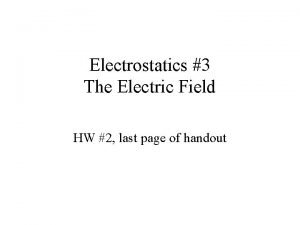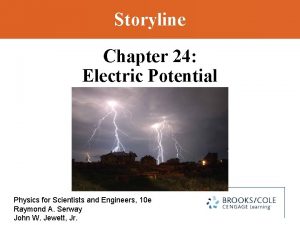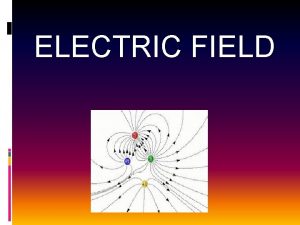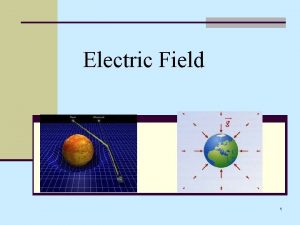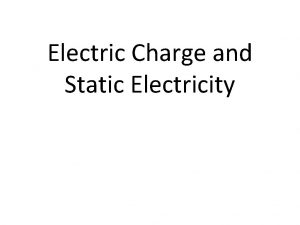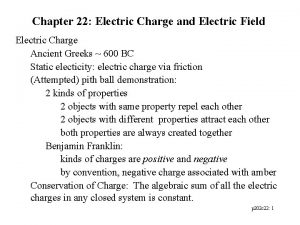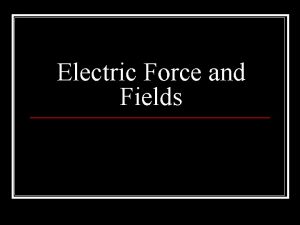Q 20 Electric Charge Force and Field 1















- Slides: 15

Q 20. Electric Charge Force and Field

1. A small object has charge Q. Charge q is removed from it and placed on a second small object. placed 1 m apart. The two objects are For the force that each object exerts on the other to be a maximum, q should be : 1. 2 Q 2. Q 3. Q/2 4. Q/4 5. 0

Q q q ( max )

2. Two identical conducting spheres A and B carry equal charge. They are separated by a distance much larger than their diameters. A third identical conducting sphere C is uncharged. Sphere C is first touched to A, then to B, and finally removed. As a result, the electrostatic force between A and B, which was originally F, becomes : 1. F/2 2. F/4 3. 3 F / 8 4. F / 16 5. 0

A, Q Spheres identical B, Q C, 0 Charges are shared equally after contact After C touching A : After C touching B : Final force between A & B :

3. Particles 1, with charge q 1, and 2, with a charge q 2, are on the x axis, with particle 1 at x = a and particle 2 at x – 2 a. For the net force on a third charged particle at the origin to be zero, q 1 and q 2 must be related by q 2 : 1. 2 q 1 2. 4 q 1 3. – 2 q 1 4. – 4 q 1 5. – q 1 / 4

2 a q q 2 a q 1

4. A particle with charge 2 C is placed at the origin. An identical particle, with the same charge, is placed 2 m from the origin on the x axis, and a third identical particle, with the same charge, is placed 2 m from the origin on the y axis. The magnitude of the force on the particle at the origin is 1. 9. 0 10– 3 N 2. 6. 4 10– 3 N 3. 1. 3 10– 2 N 4. 1. 8 10– 2 N 5. 3. 6 10– 2 N

y=2 m q = 2 C x=0 q = 2 C x=2 m q = 2 C

5. A charge Q is spread uniformly along the circumference of a circle of radius R. A point particle with charge q is placed at the center of this circle. The total force exerted on the particle q can be calculated by Coulomb's law : 1. just use R for the distance 2. just use 2 R for the distance 3. just use 2 p R for the distance 4. result of the calculation is zero 5. none of the above

Q q R f 0 by symmetry.

6. A particle with charge Q is on the y axis a distance a from the origin and a particle with charge q is on the x axis a distance d from the origin. The value of d for which the x component of the force on the second particle is the greatest is : 1. 0 2. a 3. a 2 4. a/2 5. a/ 2

Q r a f d q

7. A particle with a charge of 5 10– 6 C and a mass of 20 g moves uniformly with a speed of 7 m/s in a circular orbit around a stationary particle with a charge of 5 10– 6 C. The radius of the orbit is : 1. 0 2. 0. 23 m 3. 0. 62 m 4. 1. 6 m 5. Orbit is impossible

Q = 5 10– 6 C m = 20 g v = 7 m/s q = 5 10– 6 C R Circular motion requires a centripetal force. Coulomb force between the particles is however repulsive, and hence centrifugal.
 Chapter 21 electric charge and electric field
Chapter 21 electric charge and electric field Chapter 21 electric charge and electric field
Chapter 21 electric charge and electric field K constant unit
K constant unit Chapter 21 electric charge and electric field
Chapter 21 electric charge and electric field Force on charge in electric field
Force on charge in electric field Difference between charge and electric charge
Difference between charge and electric charge Difference between static and current electricity
Difference between static and current electricity Electric potential energy equations
Electric potential energy equations Electric field and electric potential
Electric field and electric potential Electric potential unit
Electric potential unit Chapter 17 section 1 electric charge and force answer key
Chapter 17 section 1 electric charge and force answer key Electric field and magnetic field difference
Electric field and magnetic field difference Electric field and magnetic field difference
Electric field and magnetic field difference Magnetic field
Magnetic field Electric field of a finite line charge
Electric field of a finite line charge Electrostatics formula
Electrostatics formula




